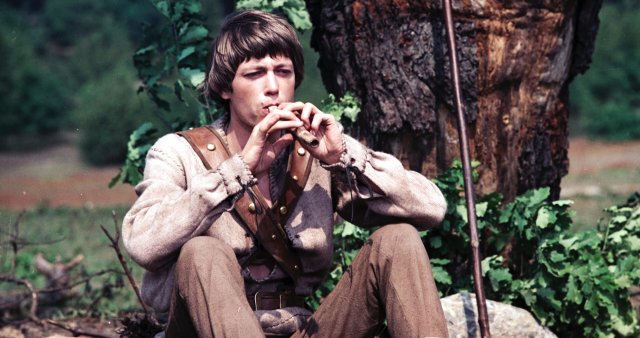The shepherd as a rabbit guardian, from the Defa fairy tale film of the same name from 1977
Photo: Defa Foundation
Sometimes trigger warnings can also be triggering. For example, the one that the “MDR” recently sent in its children’s program ahead of “Hasenwachter”, a children’s film by Defa from 1977. The following program, it was said, contained passages “that can have a discriminatory effect from today’s perspective.” How is that?
In the fairy tale, based on Ludwig Bechstein, a poor shepherd wants the beautiful princess as his wife and therefore has to look after the king’s hundred rabbits. If the hero loses even one of them, he loses his life. This is definitely in danger because the princess definitely doesn’t want to marry the poor bastard. As a fortune teller in disguise, she asks him for a bunny and in return wants to tell him his future, whereupon the bunny keeper does the same: “I read from your hand that you lie and cheat. What do I care about the heartlessness of a gypsy? You’re not much good…” And then, after they’ve both kissed each other: “If you had blonde hair; but you are careless and dissolute and let every man kiss you…” The young man then tears off her gold earrings from the alleged Sintezza – hence the warning before the start of the film.
Like children’s books that are getting old, old children’s films also document the zeitgeist of their creation. Under no circumstances should the wonderful stories of Michael Ende and Astrid Lindgren be canceled or rewritten. In Bechstein’s original fairy tale, however, the fortune teller does not appear at all; an idea from the director and screenwriter Ursula Schmenger. What sense does it make to pass on such derogatory antigypsy prejudices to children today?
nd.DieWoche – our weekly newsletter

With our weekly newsletter nd.DailyWords look at the most important topics of the week and read them Highlights our Saturday edition on Friday. Get your free subscription here.
The scene in question was already discriminatory in 1977 – against the approximately 300 Sinti who still lived in the GDR. And as far as the “Zeitgeist” in the GDR is concerned: “Ede and Unku”, the children’s book by Alex Wedding from 1931, was school reading. But when the writer Reimar Gilsenbach wrote about the fate of Unku and the other Sinti, his articles were not printed in the GDR. Kaula, Unku’s cousin, was the only member of the family to survive the genocide. Gilsenbach helped her to receive a victim’s pension as a victim of the Nazi regime; also Sintezza Margarete Kraus, who was unable to name three witnesses for her deportation when she first applied. However, their relatives were all murdered. But she still had the Auschwitz prisoner number tattooed on her forearm.
During all the commemorations for the liberation from fascism, no speaker in the GDR ever uttered a single syllable in memory of the murdered 500,000 Sinti and Roma. In June 1985, the authorities prohibited a minute’s silence that was supposed to take place in the park cemetery in Marzahn, near which the forced camp had been located from 1936 to 1945, for around 1,200 Sinti, most of whom were murdered in Auschwitz.
